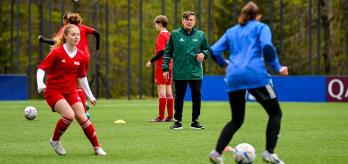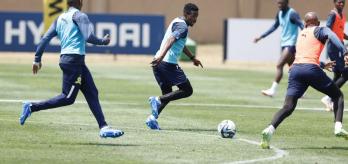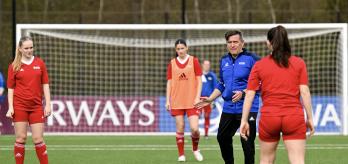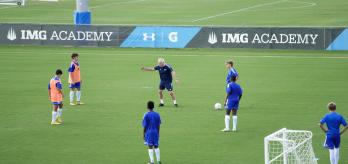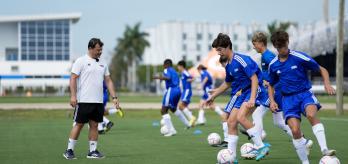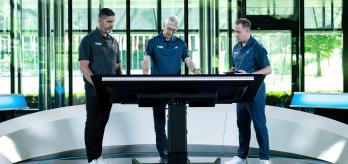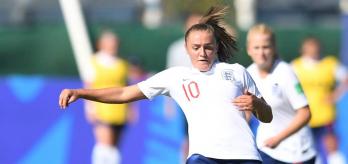A combination of individual skill, crosses and link-up play is needed in order to successfully break down a low block, and knowing when to apply each of these aspects is just as crucial.
This session will focus on all of these aspects and has been prepared by former England U-21 coach Aidy Boothroyd. Working with a young group of players, these sessions aim to give them the tools and skills to break down low defensive blocks. A 1v3 attacking scenario that focuses on individual and solo skills is followed by a 3v2 based attacking scenario that concentrates on combinations and link-up play before a 4v4 attacking situation drill that focuses on crossing and cutbacks. The session finishes with an 11v11 game centring on breaking down a low defensive block.
Session overview
-
Part 1: 1v3 attacking scenario: individual and solo skills
-
Part 2: 3v2 attacking scenario: penetrative passes and combinations
-
Part 3: 4v4 plus support players: crosses, cutbacks, whipped and clipped balls
-
Part 4: 11v11 game: breaking down a low block
In this session, the number of outfield players required for each exercise changes. Parts 1 and 2 involve 12 players, part 3 has 13 and part 4 has 20 outfield players and 2 goalkeepers.
If you have a total of 22 players or more, it may be possible to split them into two groups and play parts 1, 2 and 3 simultaneously on separate pitches with two different coaches before bringing all of the players together onto the same pitch to complete part 4. If the group is smaller, then consider sending the spare players away to work on another exercise with another coach.
Key coaching points
- Switch the ball from side to side and look for ways to play through and penetrate the defence.
- Look to get the ball into the wide areas and get around the back of defenders when the opposition is defending narrowly.
- Attacking players should not be afraid to take on defenders and create goalscoring opportunities themselves.
- Understand when to dribble or use individual actions and when to use combinations and link-up play.
- Make good use of all 5 lanes when moving the ball across the field or looking to penetrate the defence.
- Use intelligent movement and occupy space so that it draws out defenders and opens up spaces for other team-mates to penetrate and find goalscoring opportunities.
- When crossing the ball, try to get into areas that give the defending team little time to adjust to or prepare for the cross, such as getting around the back of the defence or into the half-space.
This session was designed to give attackers the ability to increase their efficiency in the final third when coming up against a low block. The key question is: how can players find ways to penetrate compact defences, both as individuals and as a group?
Part 1: 1v3 attacking scenario: individual and solo play

This session aims to give players the opportunity to focus on their individual ability when coming up against defenders in and around the penalty area. The intention is to give the attacking players the encouragement to use their skill so that they can work their way past multiple defenders and create their own goalscoring chances. To translate this into a match situation, attacking players should have the confidence to make dribbles, use quick movements with the ball and be creative when they come up against multiple defenders when in attacking scenarios.
-
Create a pitch 30m in length and 40m in width.
-
Use one full-size goal with a goalkeeper to defend it.
-
Split 12 players into 3 groups of 4.
-
Position the first group (the action players) inside the area.
-
Position the second group (the wide players) in the wide areas – two players on each side.
-
Position the third group (the central players) across the length of the area.
-
Play for a total of 20 minutes and switch the roles of the groups frequently.
-
The ball starts with the central support players and they combine until they decide to pass the ball into the area for the action players.
-
When the ball is played into the area, the player who receives the ball becomes an attacker.
-
The other action players become defenders to create a 1v3 scenario.
-
The player with the ball has to try and score, whilst the three players not in possession have to prevent the attacker from scoring.
-
The attacker can combine with the central and wide support players.
-
If a defender takes the ball from the attacker, they then become the attacker with the previous attacker now having to defend.
-
If the goalkeeper receives the ball, they should play the ball to the central or wide support players and the exercise continues.
-
Limit the central and wide support players to just one touch in order to speed up the exercise.
-
The attacking player should try to perform skills, dribbles and individual play in order to put themselves into goalscoring situations.
-
When attacking, the player with the ball should try to play without fear and not be concerned about making mistakes.
-
Both attackers and defenders should be ready to transition quickly. For example, if a defender wins the ball, their mindset should shift immediately to "attack".
Part 2: 3v2 attacking scenario: penetrative passes and combinations
This drill works more closely on combinations and link-up play when in the final third. By creating 3v2 scenarios, the attacking players are able to develop their ability of playing themselves into good goalscoring situations as an attacking group. Also, the support players can be encouraged to join the attack and use good movement to increase these goalscoring chances. The players learn how to consciously make effective combinations and movements to get past defenders.
-
Create a pitch 30m in length and 40m in width.
-
Use one full-size goal with a goalkeeper to defend it.
-
This exercise requires a total of 12 players.
-
4 support players are positioned in the wide areas – 2 on either side.
-
3 support players are positioned in the central area – in front of the area.
-
5 players are positioned inside the area; 2 players to defend, 2 players to attack and 1 floating player.
-
Play for a total of 20 minutes.
-
The ball starts with the 3 players in the central support area.
-
The ball is played into the players inside the area, where a 3v2 scenario is activated.
-
The 2 players who have the ball are joined by the floating player and have to attack the goal.
-
The 2 players without the ball have to prevent them from scoring.
-
The team in possession can use the central and wide support players to link up with.
-
If the team without the ball wins possession, they have to attack the goal, whilst the team who lose it have to try and win it back again.
-
The floating player supports the team in possession at all times.
-
Variation 1: To add intensity, players can only score a goal with a first-time strike.
-
Variation 2:
-
The support players can now follow their passes into the area and become an active part of the attack.
-
The support players can have as many touches as required.
-
-
Players in possession should constantly think about their movement with and without the ball.
-
Players should consider how to create space for one-touch finishes for themselves and their team-mates.
-
When following passes, the support players should move with the ball and find new areas in which to influence the attack.
Part 3: 4v4 plus support players: crosses, cutbacks, whipped and clipped balls
In this exercise, the wide players are given a number of varied crossing opportunities to work on. Instead of playing crosses from wide areas, the wide players focus on crossing from the edge of the penalty area as well as working the ball to the byline and cutting the ball back for advancing attackers. Applying this to a match situation helps attackers to know what kind of cross they should play, depending on how the action is unfolding.
-
Create a pitch 30m in length and 40m in width.
-
Use one full-size goal with a goalkeeper to defend it.
-
This exercise requires 13 players.
-
5 support players need to position themselves outside the area; 2 on either side of the wide areas and 1 in the central area.
-
4v4 inside the area.
-
Play for a total of 20 minutes and rotate the support players with the action players every so often.
-
The ball starts with the central support player, who needs to play the ball into the area towards one of the players.
-
The team with the ball is the attacking team and the opposite team needs to win the ball back.
-
The team with the ball needs to combine and play a pass into the wide support players.
-
The wide support players need to either play an early cross from the edge of the area or carry the ball to the byline and make a cutback.
-
The attacking team needs to try and meet the cross in order to score.
-
If the defending team wins the ball back, they should pass to a neutral support player to initiate their own attacking move.
-
Only goals scored directly from crosses count.
-
Variation 1: Wide players are only allowed to play first-time crosses or cutbacks.
-
Variation 2: Wide players can carry the ball into the penalty area to make crosses and cutbacks.
-
Variation 3: Full-backs and wing-backs should overlap into the wide areas before crossing.
-
The wide players should look to pick out attacking players when crossing rather than playing it blindly.
-
The type of cross that a player needs to choose will depend on the build-up of the attack. The kind of pass played into the wide player, as well as the space they occupy, also need to be taken into account.
-
The wide players should be ready to make runs in behind so that they can give good crossing options.
-
The full-backs and wing-backs need to time their runs in tandem with the action that is developing so that they can arrive at the right time and provide a good cross.
-
The attacking players in the centre should time their runs to match the cross of the wide player.
Part 4: 11v11 game scenario: breaking down a low block
This exercise looks to bring all of the aspects from the previous drills together so that the attacking team have all the tools at their disposal in order to break down a low block. Operating within a 4-3-3 formation, the attacking team should be encouraged to take on defenders, stretch the pitch, offer intelligent movement and combinations so that they can displace defenders in a low block, giving them opportunities to go on and score.
-
Organise an 11v11 game inside 1 half of a full-size pitch.
-
Use 1 full-size goal.
-
The orange team defends the goal using a low block in a 4-4-2 formation.
-
The blue team attacks the goal using a 4-3-3 formation.
-
The ball starts with the goalkeeper of the blue team.
-
The blue team has to try and score and the orange team just needs to defend.
-
If a goal is scored, the ball goes out of play or an attack breaks down, the game restarts with the goalkeeper from the blue team.
-
Play for 20 minutes.
-
Increase the size of the pitch so that it is 75m in length.
-
Add another goal at this end for the blue team to defend.
-
The orange team should now adopt a 4-2-3-1 formation and play with a number 9.
-
The orange team are now able to try and score when they win the ball back.
-
The blue team should organise itself defensively in the transition.
-
If a goal is scored or the ball goes out of play, the game should restart with the blue team’s goalkeeper.
-
When progressing the ball forward, look for width and depth to create space and pull defenders out of position.
-
Attacking players should look for pockets of space in between opposition defenders to pull them out of position, thus creating areas of space for their team-mates to attack and penetrate.
-
Pockets of space can also be found in between the opposition’s defensive line.
-
When passing out wide, aim to pass the ball into the movement path of the intended target, which allows the winger to turn and take on a defender who has been pulled out of position.
-
By occupying and creating space, the attacking team can initiate one-twos through the middle and penetrate the defensive line.
-
The same method can help to create space for the attacking players to get around the back of the defence or in behind.
-
When the ball reaches a crossing position, the attackers must make coordinated runs to the near and far post.
















